Unless you come from a Jewish family or spend a lot of time with Jewish friends, you may not be familiar with hamantaschen. These cookies are traditionally associated with the Purim holiday, which begins tonight at sundown. I always loved Purim as a child, because unlike most of the other more somber holidays of my family’s religion Purim was all about celebration. There was an annual Purim carnival at our temple where we played games, wore masks and costumes, and stuffed ourselves with treats like hamantaschen, and it was basically one big party. I’ll spare you an in-depth lesson on the history of the holiday – you can Google it if you’re interested – just know that the triangular shape is a defining characteristic of these cookies.
When I was young, the filling was typically some type of jam, fruit preserves, or sweetened poppy seeds, but these days you can find all sorts of sweet and savory variations. I’m a bit of a purist when it comes to traditions that are near and dear to me, so I don’t do anything crazy with my hamantaschen filling (you all can keep the pizza and nutella for yourselves). Since I’ve always been a fan of apricot hamantaschen and I adore fig anything, I combined the two with some lemon, spices, and chopped pistachio for a bit of an update on a classic. If you’re not an apricot fan, use all fig; if not into the fig thing; double the apricot. The filling bakes up into a chewy, sticky center, and since it contains very little liquid there’s less of a chance that it will leak out while the cookies are in the oven.
I make this gluten-free dough with dairy-free shortening instead of butter, which gives the baked cookies a lovely soft and crumbly texture. They’re tender and flaky and pretty much melt in your mouth, and a touch of lemon zest in the dough gives them a little something extra. The bottoms get nicely browned and crisp, while the tops stay relatively pale and a touch soft – it’s a terrific contrast. For the record, I suspect they’d make fabulous thumbprint cookies if you want to bake them on any other day besides Purim.
A note on timing before we get started: after you make the dough it has to chill for at least 30 minutes to firm up, and it then needs at least 15-20 minutes to soften enough to roll out. So when you’re preparing to make these hamantaschen, please bear in mind that you need to account for that inactive time between making the dough and actually assembling the cookies – this isn’t a recipe you can accomplish in an hour from start to finish.
Okay, let’s make some hamantaschen! In the interest of maximizing time we’ll make the dough first so it can chill while we do the filling.
Add your sugar and shortening to a mixing bowl, and cream them together on medium-high speed for about 2 minutes until the sugar is dissolved and the mixture is pale, creamy, and slightly aerated.
Pro tip: you may want to start the mixer on low speed and increase it once the sugar is sticking to the shortening so the granules don’t go flying out of the bowl.
Add the eggs and beat until they’re completely incorporated; then mix in the vanilla and lemon zest.
Add the dry ingredients in two or three increments, beating until you have a shaggy, sticky, mixture.
Gather up the dough and form it into a smooth mound, then press into a disc, wrap tightly in plastic, and pop it into the freezer to chill for 30 minutes. (If you want to make the dough ahead of time, you can refrigerate it for several hours or overnight.)
Make the filling while the dough chills. Give the pistachios a quick buzz in the food processor to chop them, and set them aside. Add the apricot, fig, lemon zest, lemon juice, cardamom, ginger, and salt to the food processor, and let it run until the dried fruit is very finely chopped and everything pulls together into a mass.
Add the pistachios and pulse until they’re incorporated into the filling. At this point I recommend chilling the filling until you’re ready to assemble the hamantaschen; it’s extremely sticky, and easier to work with when cold.
When the dough is chilled, let it sit at room temperature until it’s soft enough for you to roll it out without cracking. Depending on how warm your kitchen is, this may take anywhere from 15-30 minutes. When you’re ready to start rolling, preheat the oven.
I recommend sweet white rice flour for dusting the work surface and dough. If you want to make things even easier for yourself, dust a large sheet of parchment with the flour and roll the dough on there – you can rotate it after every few strokes to ensure that you’re getting even results, and when it’s time to turn the dough, just lift up the entire sheet of parchment, flip to over, and peel it off the dough. You’re aiming for a thickness between ¼ and ⅛ inch when all is said and done.
Once your dough is rolled out use a 3-inch cookie cutter to punch out rounds, and transfer them to a sheet pan. (If you don’t have a cookie cutter, you can use the rim of a round drinking glass.) Gather up the scraps, re-roll the dough, and punch out more rounds; continue doing that until you’ve used up all the dough. Unlike gluten-containing dough, GF dough doesn’t suffer from being reworked multiple times.
Set yourself up with trays of dough rounds, a bowl of filling with a teaspoon for measuring, and a beaten egg for brushing onto the dough (if you don’t have a pastry brush for that you can use your fingers). Filling and shaping the hamantaschen takes a little time, but once you’ve made a few you’ll get a hang of the process and find your rhythm. Still, I recommend laying a damp tea towel over the unfilled dough rounds to keep them from drying out while you work.
Set a dough round on your work surface and scoop out a packed teaspoon of filling. Please only use a teaspoon here, because if you over-fill the dough it will tear or burst. Roll the filling into a ball, flatten it slightly into a disc, and place it in the center of the dough. Brush the exposed dough with beaten egg.
Gently lift up the left side of the dough round and fold it toward the center so it partially overlaps the filling at an angle.
Lift up the right side of the dough and fold it toward the center as you did with the left, pinching the ends together at the top.
Lift the bottom of the dough round up, tuck the left side under the flap you already folded over on the left side, and lay the right side on top of the flap you folded on the right side. Make sense? Now you have a triangular cookie, and a triangle of exposed filling in the center.
Gently press the seams together, brush the dough with egg wash, and transfer the shaped hamantaschen back to the sheet tray.
See? You’ve got this! Repeat those steps with all the remaining dough rounds. (Side note: I know the filling is super sticky and can get all over your hands. Either keep a bowl of cold water on your work station to dip and wipe them every so often, OR form all the filling discs at once, then shape the hamantaschen.)
Once you’ve got them all lined up on your trays, bake the hamantaschen for 25 minutes. Let the baked trays sit on cooling racks for 2-3 minutes, then transfer the cookies directly to the racks to finish cooling. If you need to store the hamantaschen, keep them at room temperature in an airtight container or zipper bag, but I doubt you’ll need to worry about that – these cookies are going to disappear. Happy Purim!
- Dough:
- 95g (¾ cup) brown rice flour
- 95g (⅔ cup) white rice flour
- 47g (6 Tbsp) tapioca starch
- 47g (5 Tbsp) potato starch
- 16g (3 ½ tsp) sweet white rice flour
- 5g (2 tsp) xanthan gum
- 4g (1 tsp) baking powder
- ½ tsp kosher salt
- 112g (8 Tbsp) dairy-free shortening, room temperature
- 108g (½ cup + 1 Tbsp) organic cane sugar
- 2 large eggs
- 1 tsp lemon zest
- 5ml (1 tsp) vanilla
- Filling:
- 14g shelled pistachios (yield 1 Tbsp chopped)
- 6 oz dried apricots
- 6 oz dried figs, stems removed
- 20ml (4 tsp) lemon juice
- 1 tsp lemon zest
- ¼ tsp ground cardamom
- ⅛ tsp ground ginger
- ⅛ tsp salt
- Assembly & Baking:
- Sweet white rice flour for dusting
- Parchment paper
- 1 egg, beaten
- Damp tea towel
- Make the dough: Add dry ingredients (brown rice flour through salt) to a mixing bowl, whisking to combine thoroughly; set aside.
- Using an electric mixer, beat shortening with sugar on medium-high speed until pale, creamy, and slightly aerated, about 2 minutes. Beat in eggs, scraping down sides if necessary. Reduce speed to medium-low and beat in lemon zest and vanilla.
- Add half the flour mixture and mix on medium-low speed to combine; mix in remaining flour mixture, increase speed to medium-high and beat until dough is sticky and shaggy.
- Turn dough out of processor and form into a disc - it will be very soft. Wrap tightly in plastic and freeze for 30 minutes or refrigerate for several hours until firm.
- Make filling: In a food processor, pulse nuts until finely chopped, transfer to a bowl and set aside. Add apricots and figs to food processor along with lemon juice and zest, cardamom, ginger, and salt. Puree until fruit is very finely chopped and mixture gathers into a ball. Add chopped pistachios and pulse to combine thoroughly. Refrigerate until ready to use.
- Rest dough: Remove dough from freezer and let sit at room temperature for 20-30 minutes before rolling out, just until soft enough to roll without cracking.
- Roll and cut dough: Preheat oven to 350˚F. Line two sheet pans with parchment and set aside. Sprinkle work surface with a very light dusting of sweet white flour, and use a rolling pin to roll out the dough to ¼ inch thickness. Dust surface lightly with flour, lift dough with a pastry scraper, and flip dough over (alternatively you can roll out dough on a sheet of parchment and flip over the entire sheet). Dust dough surface again and continue rolling out to slightly thicker than ⅛ inch.
- Use a 3-inch cookie cutter or round drinking glass to punch rounds out of the dough, cutting as close together as possible. Line up the rounds on the prepared baking sheets, then gather up the scraps and roll out again. Punch rounds out of the re-rolled dough and add them to the sheet pans. You should end up with 24-30 rounds. Cover rounds with a damp towel as you work to prevent dough from drying out.
- Assemble and shape hamantaschen: Scoop out a packed teaspoon of filling, form into a ball, and flatten into a disc. Place disc in the center of a dough round. (It’s tempting to pack extra filling in there, but please don’t - it will likely cause the cookies to unfold during baking, and the filling will leak out.)
- Brush exposed dough with beaten egg. Fold the left side of the dough toward the center so the flap now covers the left third of the cookie at an angle. Grasp the right side of the dough circle and fold it toward the center in the same manner, overlapping it at the top to form a triangular tip and pinching to seal. Fold the bottom edge of the dough upward to complete the triangle, leaving a triangle of filling visible. Tuck the left side of this final flap underneath the flap of dough on the left side, and let the right side rest on top of the flap of dough on the right side. This specific method keeps the flaps from buckling and prevents unfolding during baking. Pinch the corners gently but firmly to secure the dough, brush the surface of the cookie with egg, and place the formed hamantaschen back on the sheet pan. Repeat the process with the remaining dough rounds.
- When all hamantaschen have been filled, space them evenly about 1 inch apart.
- Bake: Bake cookies for 25 minutes until corners are lightly golden and dough is cooked through, rotating trays 180 degrees after 15 minutes. Cool on trays for 2-3 minutes, then transfer hamantaschen directly to a rack to cool completely. Store in an airtight container. or zipper bag at room temperature.
Use the freshest dried fruit you can find so the filling is moist and sticky. If your apricots or fig seem leathery and dry, rehydrate them in warm water for a few minutes, then drain them and gently press out excess water. Proceed with the filling as instructed.


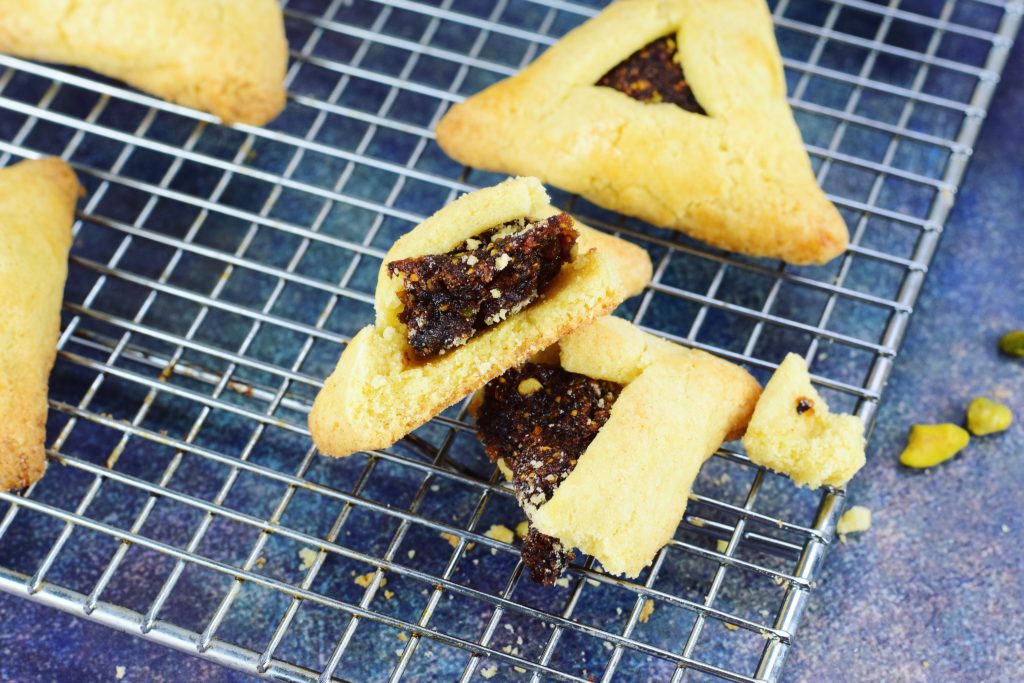
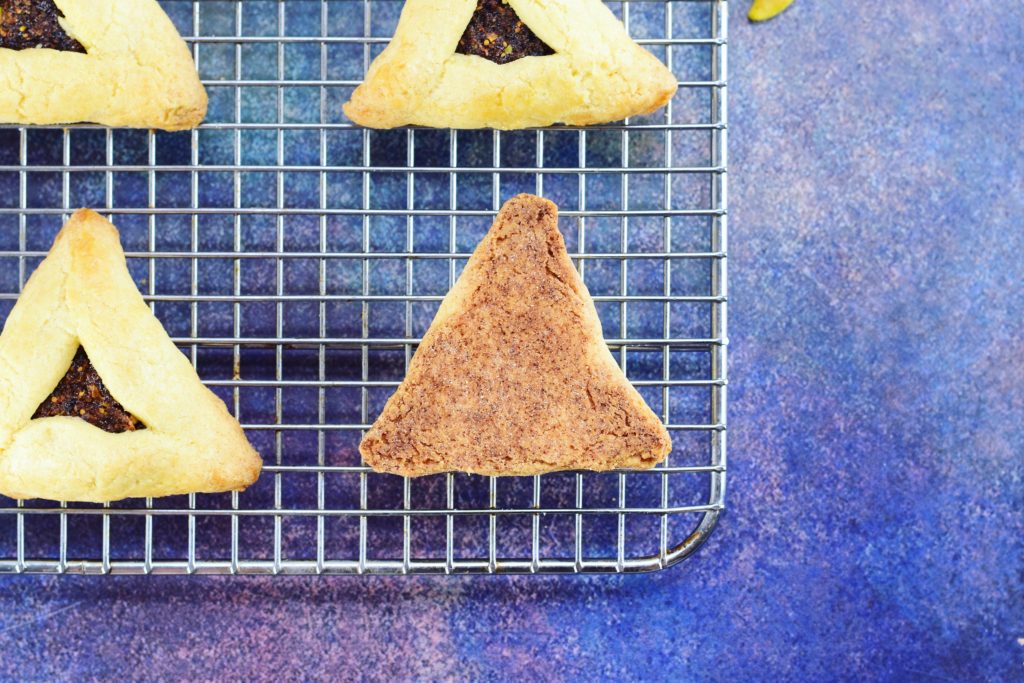
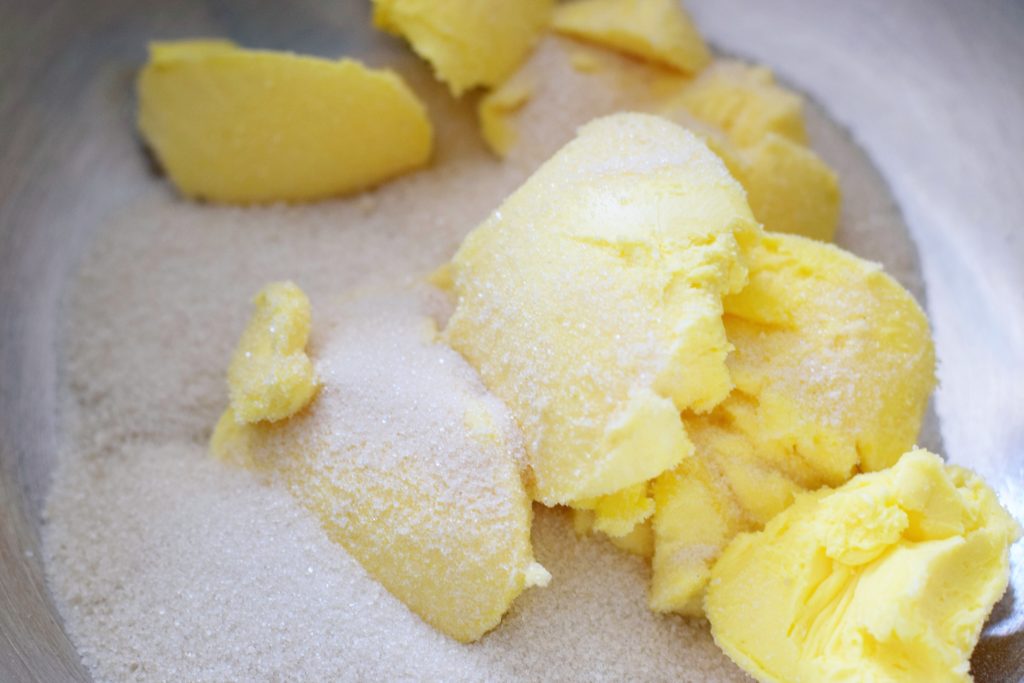
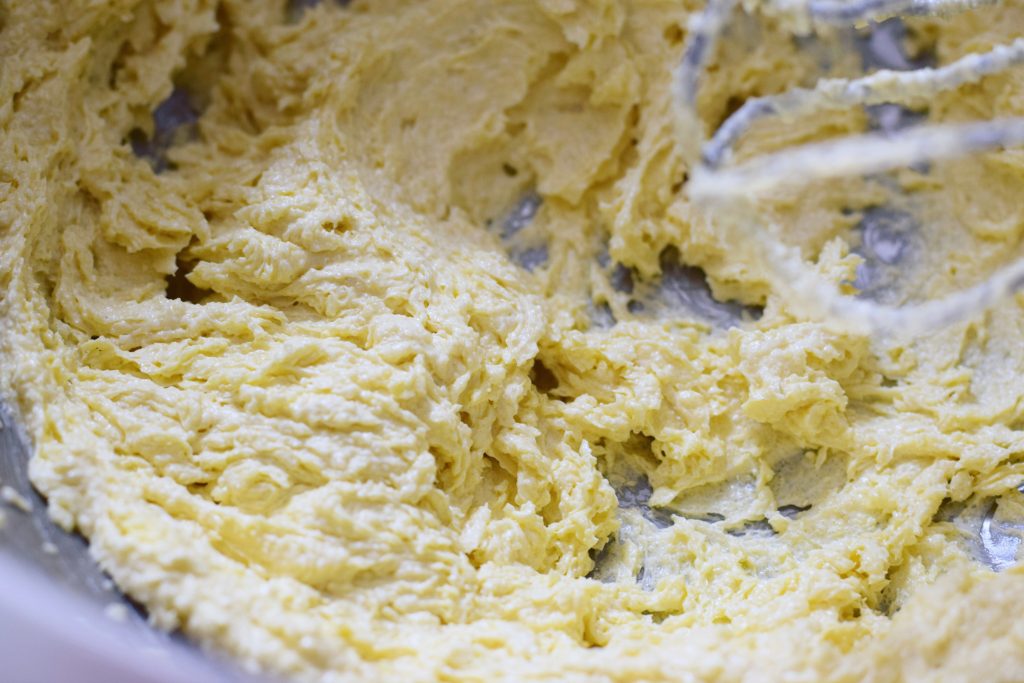
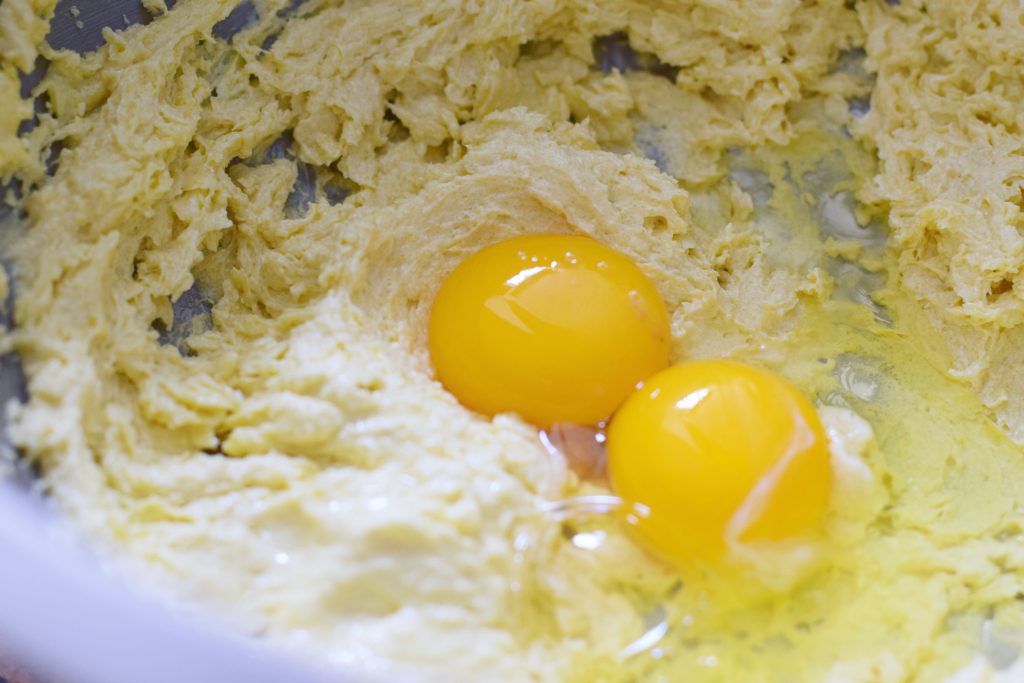
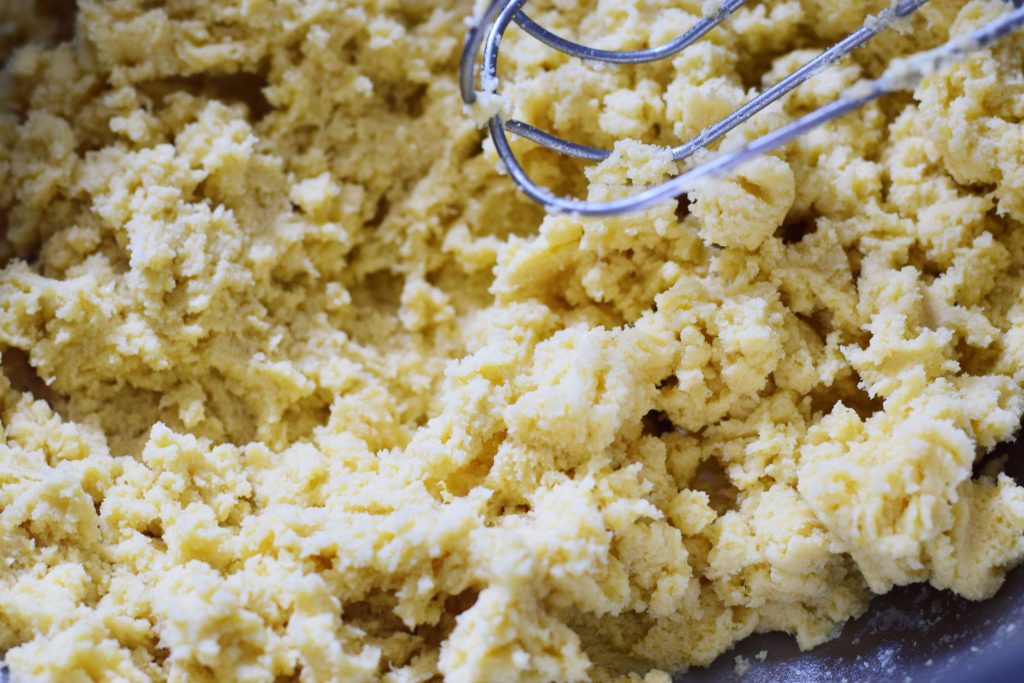
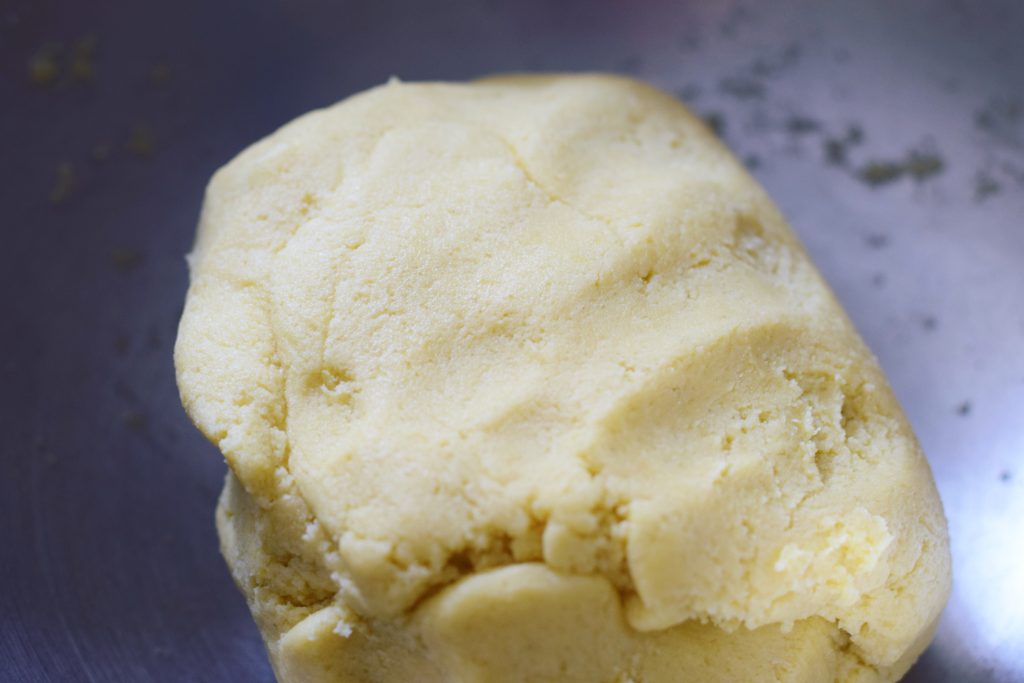



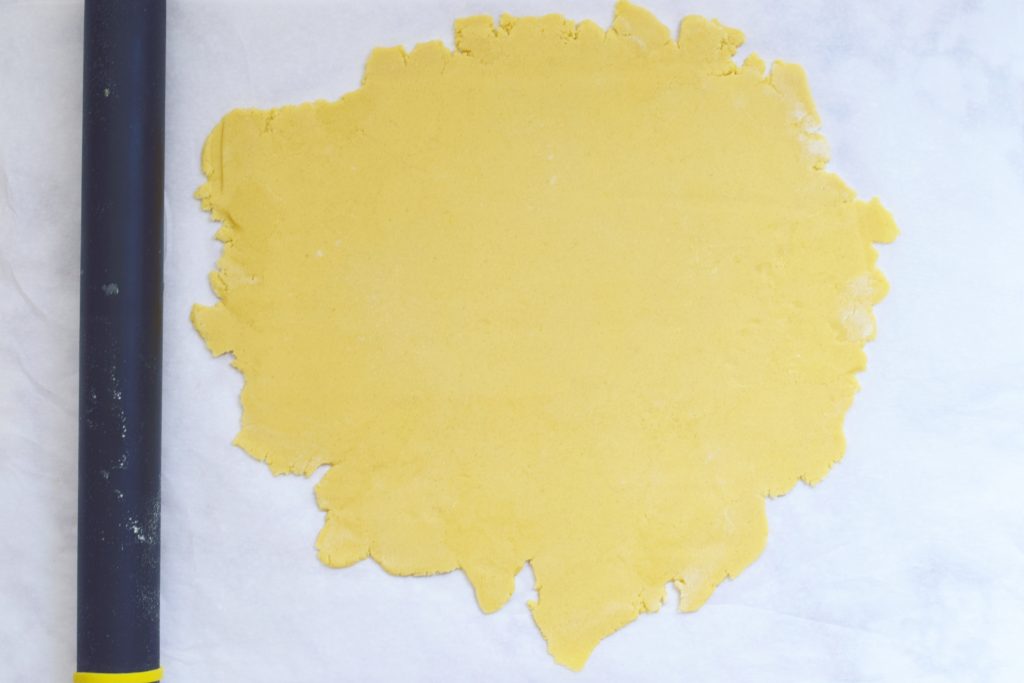
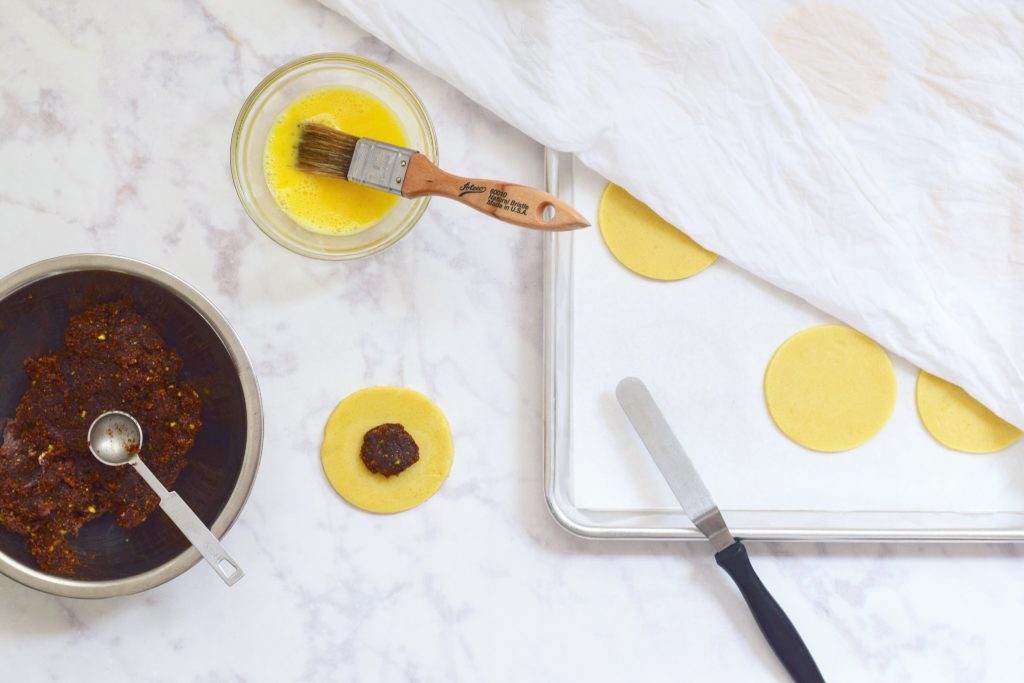
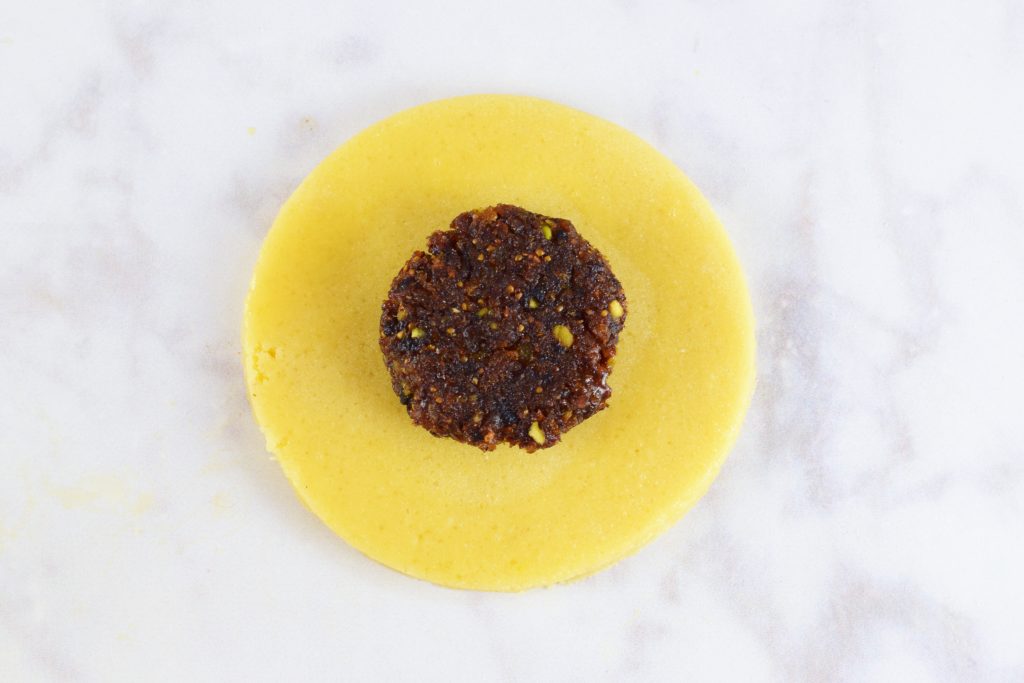
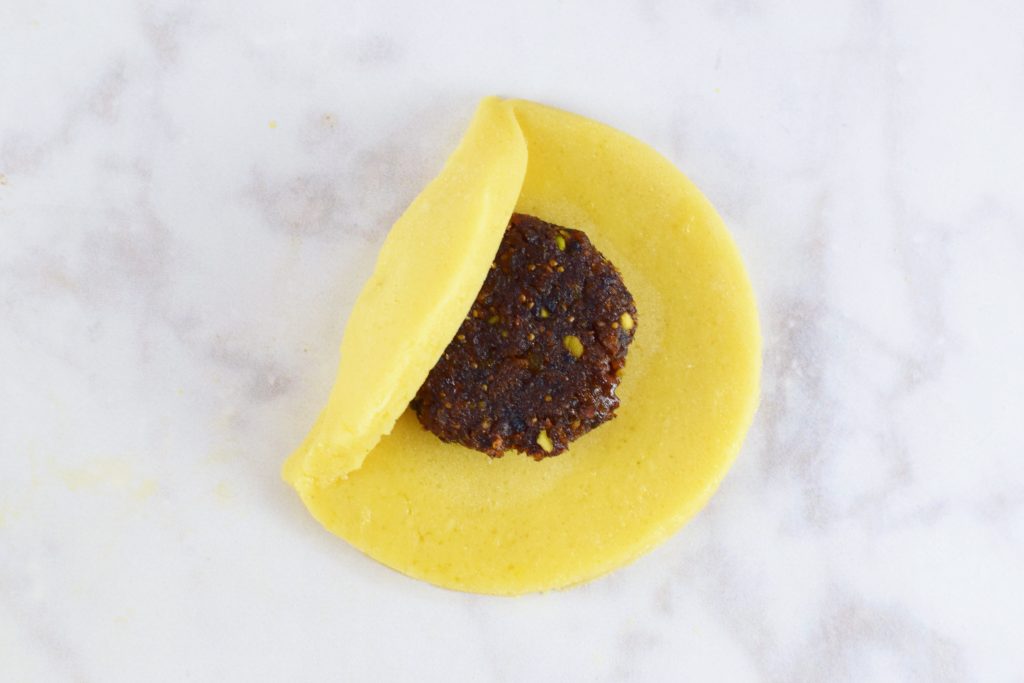
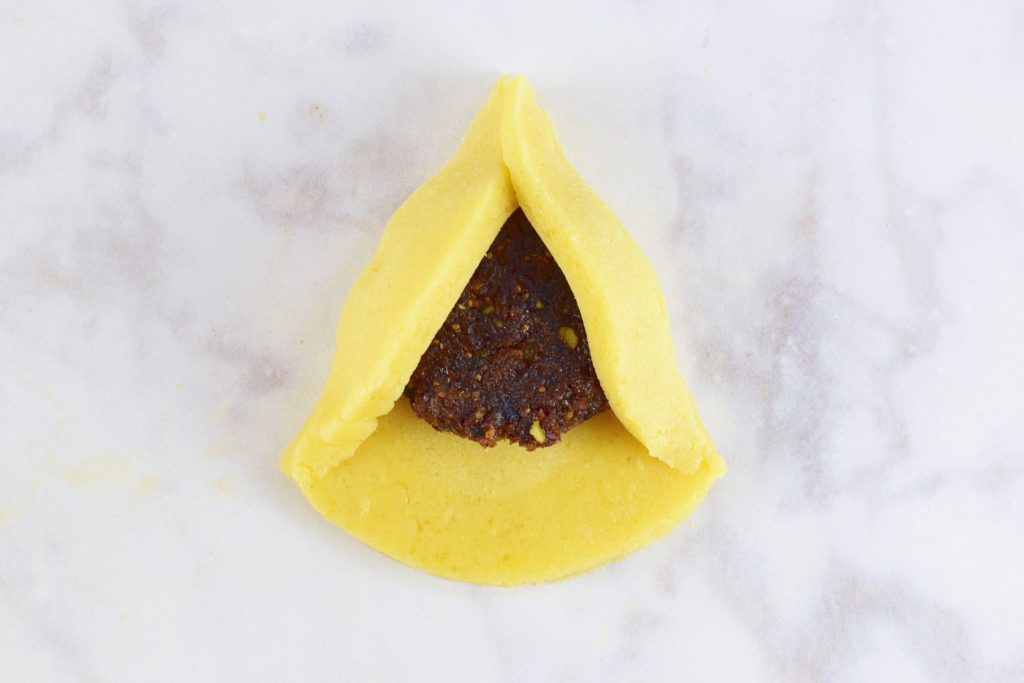
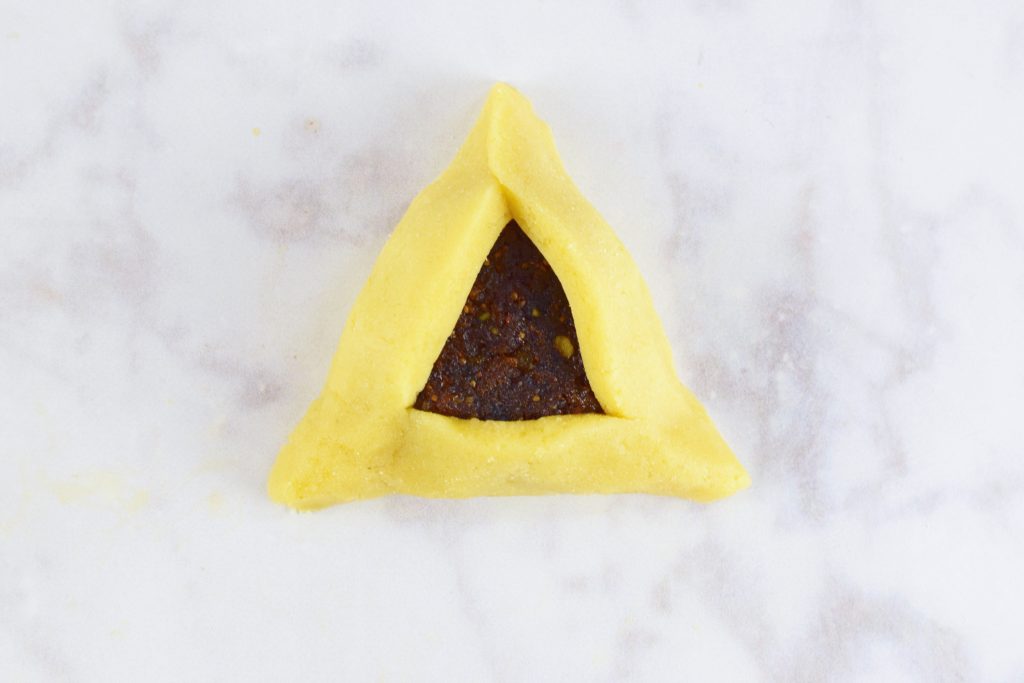
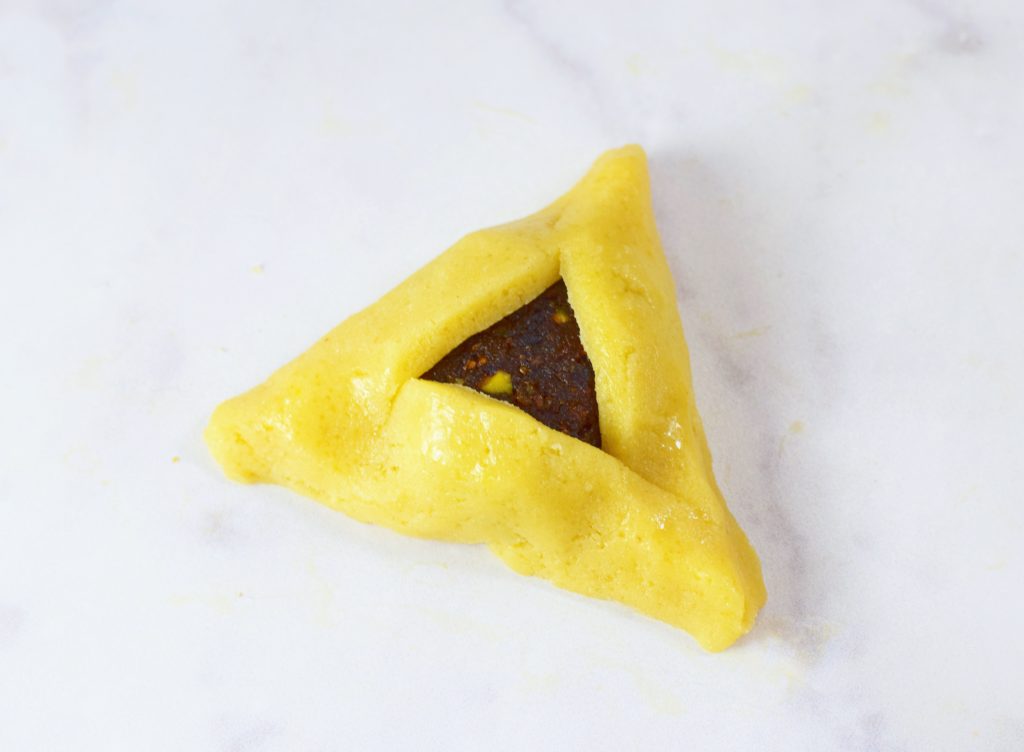
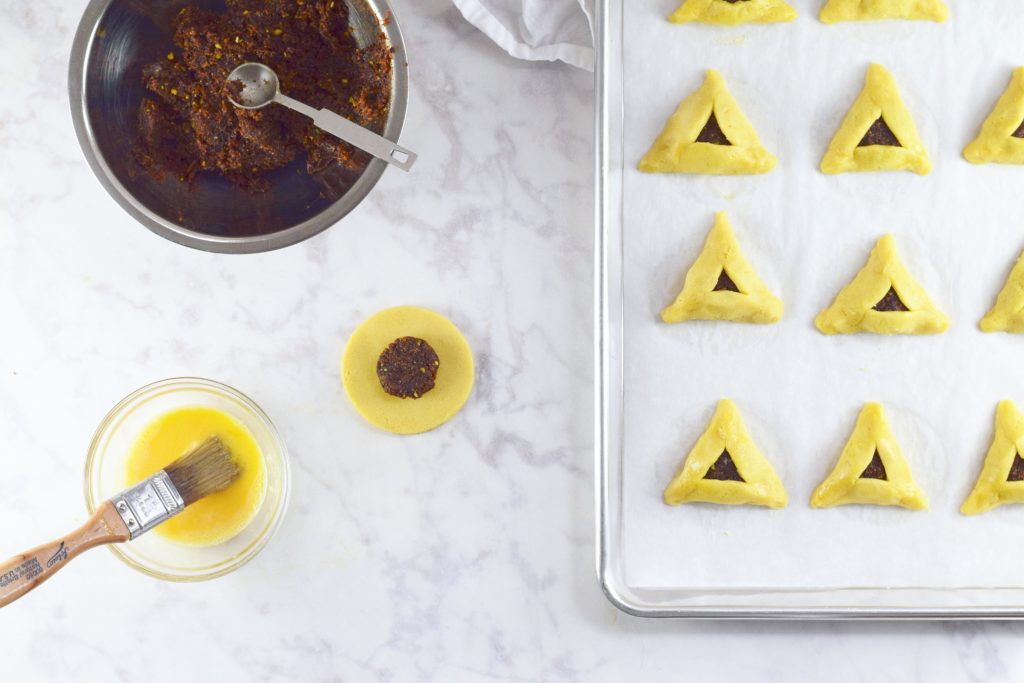
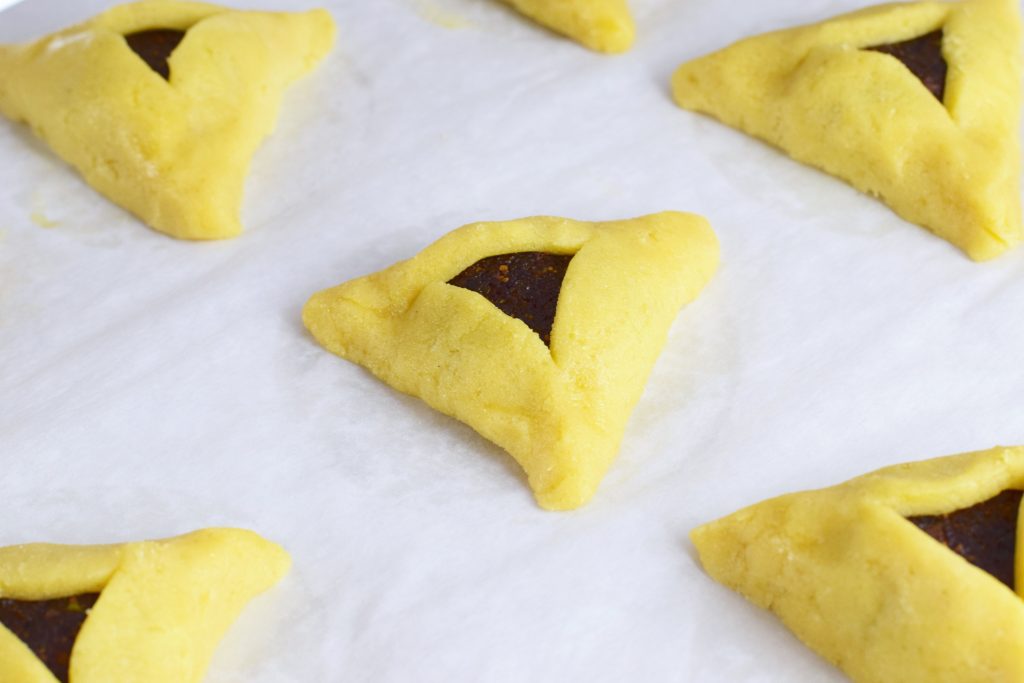
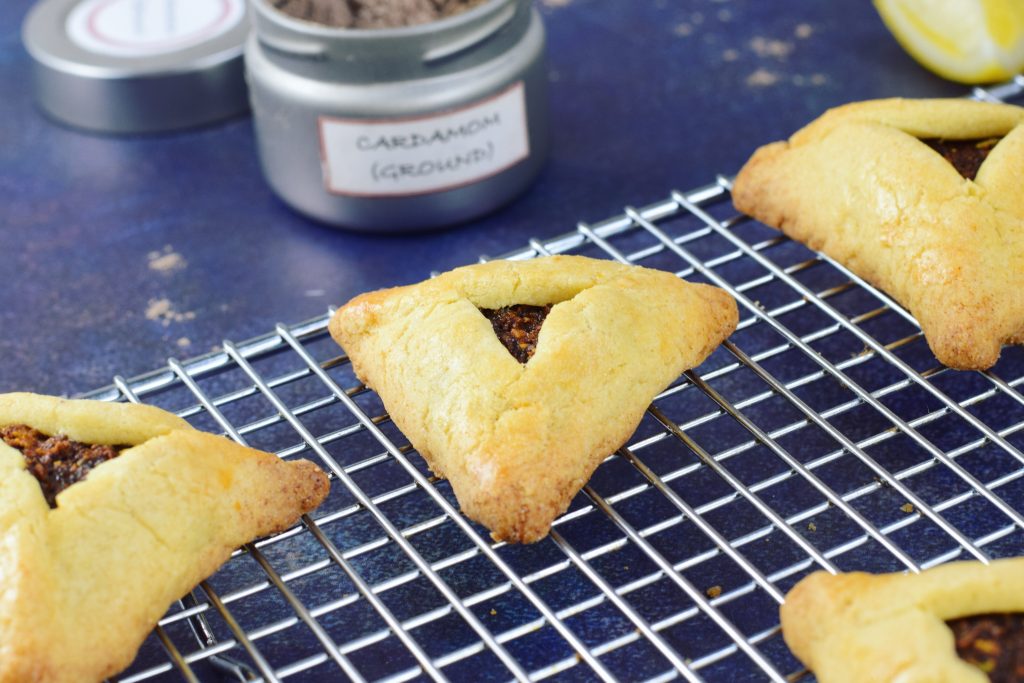


Leave a Reply